This site is supported by our readers. We may earn a commission, at no cost to you, if you purchase through links.
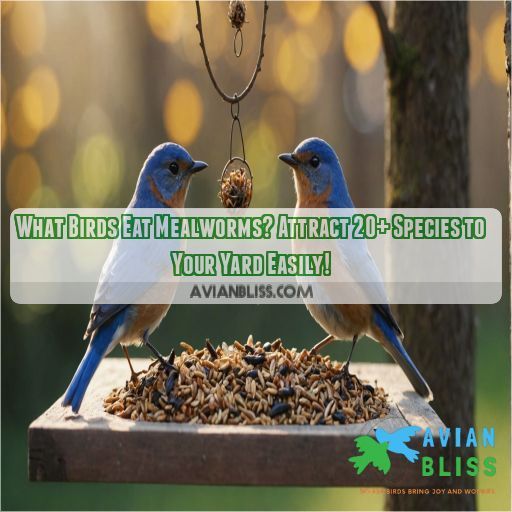
You’ll be thrilled to know that over 20 species of birds, including warblers, tufted titmice, and Carolina wrens, go crazy for these tasty treats.
If you’re wondering what birds eat mealworms, the answer is a diverse bunch! From robins to bluebirds, and even woodpeckers, these birds can’t get enough of the protein-packed mealworms.
By serving them up, you’re supporting their natural foraging behavior and helping them store fat reserves for long-distance flights.
Want to know the best ways to serve mealworms and attract these feathered friends to your yard?
Table Of Contents
- Key Takeaways
- Birds That Eat Mealworms
- Mealworms as a Food Source
- Benefits and Risks of Feeding Mealworms
- Mealworm Facts and Care
- Serving Mealworms to Birds
- Benefits of Offering Mealworms in Winter
- Tips for Attracting Birds With Mealworms
- Creating a Bird-Friendly Environment
- Frequently Asked Questions (FAQs)
- Conclusion
Key Takeaways
- It’s a bird bonanza out there, folks! Mealworms are the secret ingredient to attracting over 20 species of birds to your backyard, including warblers, tufted titmice, and Carolina wrens.
- Robins, bluebirds, and Woodpeckers are just a few of the birds that go crazy for mealworms—and for good reason! These tiny treats are packed with protein, making them the perfect snack for birds looking to fuel up.
- But don’t just take our word for it—the numbers don’t lie! Mealworms have a whopping 55% protein content, leaving crickets (20%), suet (10%), sunflower seeds (6%), and birdseed (4%) in the dust.
- Whether you’re a seasoned bird enthusiast or just starting out, offering mealworms is a great way to support the natural foraging behavior of your feathered friends and keep them coming back for more. So, why not give it a try and see the bird bonanza for yourself?
Birds That Eat Mealworms
You’re about to discover the secret to attracting over 20 bird species to your yard with a single, simple food source: mealworms! By offering mealworms, you’ll be catering to the protein needs of many bird species, from warblers and titmice to Bluebirds and woodpeckers, and more.
Warblers and Their Diet
Warblers, those colorful, lively songbirds, are insectivorous, and mealworms are a tasty treat. Their diet includes warblers, beetles, and moths.
Tufted Titmice and Mealworms
Tufted Titmice are curious, playful birds that love the challenge of finding mealworms near feeders. Offer these active foragers a tasty treat.
Carolina Wrens and Insectivorous Diet
As a birder, you’ll love Carolina wrens’ enthusiasm for mealworms – they expertly forage for them to complement their insectivorous diet.
Here are three key takeaways:
- Protein seekers: Carolina wrens need mealworms to fuel their energetic lifestyle, searching every nook for these wriggling morsels.
- Insect diet benefits: Supplementing their diet with mealworms supports their natural foraging behavior, mirroring their wild insect-hunting exploits.
- Berry bushes matter: Providing nearby berry bushes offers these birds an essential food source, diversifying their nutrient intake beyond just mealworms.
Eastern Bluebirds and Occasional Mealworms
You’ll occasionally spot Eastern Bluebirds eating mealworms, although they’re not their go-to snack. They prefer the treat on platform feeders.
| Feeder Type | Bluebird Preference | Tips |
|---|---|---|
| Platform Feeder | High | Place near shrubs for shelter |
| Tube Feeder | Medium | Use small tube feeders for easy access |
| Ground Feeding | Low | Scatter mealworms near bluebird-friendly plants |
Black-Capped Chickadees and Live Mealworms
If you want to attract Black-Capped Chickadees, offer live mealworms, a favorite snack that provides essential protein for these birds.
Towhees, Woodpeckers, and Other Mealworm-Eating Birds
You can attract towhees, woodpeckers, and other birds with mealworms; they love ’em! Consider these favorites:
- Towhees: Ground-dwellers that devour mealworms enthusiastically.
- Woodpeckers: Attracted to the protein-rich snack, especially during breeding season.
- Catbirds: Enjoy mealworms as a juicy treat, often visiting feeders repeatedly.
Mealworms as a Food Source
You’re probably wondering which birds will swoop in to devour those mealworms you’ve so thoughtfully provided.
After all, you want to attract a diverse range of species to your yard.
As a bird enthusiast, you’ll be thrilled to know that mealworms are a coveted snack for many birds, and you can easily attract 20+ species to your yard by offering them up.
Robins Switching to Mealworms
You’re interested in robins switching to mealworms! It’s no surprise, given mealworms’ high protein content. Robins now prefer mealworms over crickets for nutrition. Here’s a comparison:
| Food Source | Protein Content |
|---|---|
| Mealworms | 55% |
| Crickets | 20% |
| Suet | 10% |
| Sunflower Seeds | 6% |
| Birdseed | 4% |
Make the switch and offer mealworms to attract robins to your yard!
Storing Fat Reserves and Energy
You want to help birds store fat reserves and energy for their long-distance flights? Mealworms are a fantastic solution! Rich in protein and fat, mealworms provide the perfect supplement to support bird migration patterns and overall bird health.
Regional Mealworm Consumption Patterns
As you explore mealworms as a food source, let’s look at regional mealworm consumption patterns. Here are three interesting trends:
- North America: Kinglets and wrens love mealworms, especially during spring and summer.
- Europe: Grosbeaks and buntings enjoy mealworms, mainly during winter.
- South America: Tanagers prefer mealworms, even in urban areas, all year round.
Benefits and Risks of Feeding Mealworms
When you offer mealworms to your feathered friends, you’re giving them a treat that’s both nutritious and delicious, but you’ll also want to think about the potential risks for their health and well-being. While mealworms are a great option for many birds, remember that they should make up only a small part of a bird’s diet to avoid liver or kidney toxicity from overconsumption .
Dried Mealworms as a Great Option
Let’s get real – live mealworms can be pricey and high-maintenance! Dried mealworms are a fantastic alternative, offering the same nutritional benefits without the fuss. Plus, they’re often cheaper and have a longer shelf life, making them a great option for attracting birds to your yard.
Cheap and Nutritious but With Risks
When feeding mealworms, remember they’re cheap and nutritious, but also come with risks. Here are four key considerations:
- Mealworm allergy issues: Some birds may be allergic, so monitor their reaction.
- Overfeeding consequences: Don’t overdo it, as this can lead to bird obesity concerns.
- Nutrition balance tips: Make mealworms part of a balanced diet.
- Mealworm toxicity risks: Be aware of potential risks and take precautions.
Liver or Kidney Toxicity From Overconsumption
Be cautious not to overfeed mealworms, as this can cause liver or kidney toxicity in birds. Follow mealworm quantity guidelines and watch for toxicity warning signs to prevent health risks. Safe consumption levels vary by species, so research specific needs for your backyard visitors.
Mealworm Facts and Care
Now that you’re enticing birds to your yard with mealworms, mastering mealworm care is vital for providing a nutritious and safe treat for your feathered friends, increasing your chances of attracting 20+ species to your yard. By understanding the fascinating life cycle and needs of these tiny creatures, you’ll be better equipped to support their health and well-being.
Four Stages of Life Cycle
- Egg stage: Female beetles lay eggs that hatch into…
- Larva stage: Mealworms, the larval form, eat and grow.
- Pupa stage: They transform, emerging as adult beetles.
Longevity and Diet Requirements
You want to know how to care for mealworms. Mealworms can live up to 1 year in captivity. Here are their dietary needs and ideal storage:
| Mealworm Stage | Dietary Requirements |
|---|---|
| Eggs | Humidity and aeration |
| Larva | Bran, oats, or grains |
| Pupa | Water only |
| Adult | Fruits and vegetables |
| All stages | 60-70°F, low light |
Dehydration, Heat, and Cold Risks
Now that you know how long mealworms can live, you must protect them from extreme temperatures. Here are three risks to watch out for:
- Dehydration: Mealworms need a humid environment to thrive.
- Heat: Avoid direct sunlight, which can cause overheating.
- Cold: Keep mealworms away from drafts and freezing temperatures.
Serving Mealworms to Birds
You’re ready to start serving mealworms to the birds visiting your yard, but you need to know the best way to present them. By offering mealworms in the right way, you can attract a wide variety of bird species and provide them with a nutritious snack to keep them coming back for more.
Live Vs Dried Mealworms
You’re ready to dish out mealworms to your feathered friends! Now, the age-old question: live vs dried mealworms? Here’s a quick rundown:
| Mealworm Type | Pros | Cons |
|---|---|---|
| Live | High bird appeal, nutritious | Short shelf life, maintenance required |
| Dried | Long-lasting, easy storage | Less appealing to birds, may require soaking |
| Both | Offer variety, cater to different bird preferences | None! |
Choose live mealworms for a bird buffet extravaganza or dried mealworms for a convenient, no-fuss option.
Platform Feeders and Ground Serving
To serve mealworms, use platform feeders or ground feeders, making it easy for birds to access them. Here are some feeder options:
- Feeding trays with raised edges
- Shallow dishes on the ground
- Mealworm dispensers attached to trees
- Bird feeder designs with built-in mealworm compartments
Soaking Dried Mealworms for Appeal
To make dried mealworms more appealing, soak them in lukewarm water for a few minutes. This simple trick can make them just as enticing as live mealworms. Revitalize your dried mealworms and watch the birds flock to your yard!
Benefits of Offering Mealworms in Winter
You can make a big difference in the lives of your feathered friends by offering mealworms during the winter months. By providing this essential protein source, you’ll be supporting the health and well-being of robins, jays, woodpeckers, and other bird species that rely on mealworms to get them through the cold winter.
Essential Protein During Winter
You’re already serving mealworms to birds – now let’s talk about the benefits during winter! In the cold months, mealworms provide essential protein to keep birds healthy. Here are three reasons why mealworms are a winter favorite:
- Easy energy boost: Mealworms are a concentrated source of protein and energy.
- Seasonal scarcity: Natural food sources are scarce in winter, making mealworms a welcome treat.
- Frozen mealworm care is easy: Simply thaw frozen mealworms as needed to keep your feathered friends happy!
Robins, Jays, and Woodpeckers in Winter
In winter, offer mealworms to attract robins, jays, and woodpeckers. They’ll appreciate the protein-packed snack. Here’s a breakdown of their winter habits:
| Bird Species | Winter Behavior | Mealworm Preference |
|---|---|---|
| Robins | Migrate to warmer areas, but some stay | Live mealworms |
| Jays | Cache food for later, visit feeders | Dried or live mealworms |
| Woodpeckers | Forage for insects, visit suet feeders | Live mealworms |
| Blue Jays | Visit feeders, especially in harsh weather | Dried mealworms |
| Woodpeckers | Drum on trees to find insects | Live mealworms |
Keep in mind that each species has unique preferences.
Keeping Mealworms Fresh and Accessible
When keeping mealworms fresh and accessible in winter, remember to:
- Store them in a cool, dry place to maintain their nutritional value
- Use fresh mealworm feeders or dispensing systems to provide a steady supply
- Place accessible feeding trays near shrubs or trees for easy bird access
Tips for Attracting Birds With Mealworms
You’re ready to turn your yard into a bird haven with mealworms – now it’s time to learn how to attract them.
With the right mix of food, you’ll be well on your way to creating a welcoming space for 20+ species of birds that love mealworms .
Offering sunflower seeds, suet, and peanut hearts in addition to mealworms is a great start.
Using the right feeders is also crucial.
Keeping your yard clean and watered is essential to attract birds.
Offering Sunflower Seeds and Suet
To attract birds with mealworms, supplement with sunflower seeds and suet. Offer black oil sunflower seeds, a favorite among woodpeckers. Place suet feeders near mealworm dishes to create a bird-friendly hub. This combination will keep them coming back for more.
Planting Native Shrubs and Trees
To create a haven for mealworm-loving birds, consider planting native shrubs and trees. These provide berries, shelter, and perches, making your yard a go-to spot for birds. Here are some options to get you started:
- Juniper: A bird-friendly favorite, offering berries and cozy nooks
- Sumac: A produce-rich shrub that’s a hit with birds
- Hawthorn: A haven for nesting birds and a berry-lover’s dream
- Dogwood: A tree that’s a treat for birds, with berries and bugs galore
- Native fruit trees: Varieties that provide a tasty snack for birds and support local ecosystems
Keeping the Yard Clean and Watered
Now that you’ve planted native shrubs and trees, keep your yard clean and watered to attract birds. A well-maintained yard creates a haven for birds to thrive. Consider the following tips:
| Tips | Benefits |
|---|---|
| Remove yard debris | Reduces bird hazards |
| Maintain water features | Attracts thirsty birds |
| Preserve ground water | Supports local ecosystem |
Regular yard waste management and water feature maintenance create a safe and welcoming space for birds to enjoy mealworms and other treats.
Creating a Bird-Friendly Environment
You’re just one step away from turning your yard into a bird paradise – and it all starts with creating a bird-friendly environment. By mixing trees, shrubs, and grasses, providing a source of water, and keeping your yard free of debris, you’ll be well on your way to attracting a variety of bird species that’ll love snacking on mealworms.
Mixing Trees, Shrubs, and Grasses
When creating a bird-friendly environment, think of your yard as a restaurant – you want to offer a diverse menu that attracts a variety of customers!
Mix native trees, shrubs, and grasses to create a wildlife habitat that’s teeming with biodiversity.
Consider yard layout tips like layering plants by height and density to provide cozy nooks for birds to rest and refuel.
Providing Water and Debris-Free Yard
When creating a haven for birds, don’t forget about water!
A shallow dish or birdbath at ground level is perfect for our feathered friends.
Keep the water fresh and clean to prevent bacterial growth.
Place it near a shrub or tree for coverage.
A bird-safe yard is a debris-free yard, so tidy up and keep your birds happy and healthy!
Frequently Asked Questions (FAQs)
How do mealworms compare to other bird foods nutritionally?
Cut to the chase, mealworms are a nutritional powerhouse for birds! Compared to other bird foods, mealworms offer high-quality protein, vitamins, and minerals, making them a valuable supplement to a bird’s diet, especially during breeding season.
What role do mealworms play in a birds overall diet?
You’re offering mealworms to your feathered friends, but what role do they play in a bird’s overall diet? Mealworms provide essential protein and fat, supplementing their diet, especially during breeding and winter seasons .
Can baby birds safely consume mealworms as a food source?
[ORIGINAL TEXT]
Consider a baby robin’s first meal – a juicy mealworm from its parent’s beak. You can safely offer mealworms to baby birds, but make certain they’re gut-loaded and fresh. Moderation is key to avoid an imbalanced diet .
[/ORIGINAL TEXT]
How can mealworms be stored to maintain their freshness?
To keep mealworms fresh, store them in a shallow plastic container with air circulation, add some food like apples or oatmeal, and keep it in the fridge to slow down their growth – it’s that simple!
Are there any tips for breeding mealworms for bird feeding?
You’re ready to become a mealworm breeder! Store them in a shallow container with air circulation, feed with apples and oats, and keep them chilled. Your birds will thank you for the fresh, nutritious treats!
Conclusion
You’ve "hit the jackpot" with mealworms – a goldmine for attracting a bird bonanza to your backyard!
By serving up these protein-packed treats, you’re supporting the natural foraging behavior of over 20 species.
These species include robins, bluebirds, and woodpeckers, that go crazy for mealworms.
Now that you know what birds eat mealworms, get ready to roll out the welcome mat and create a bird-friendly haven that’s sure to delight both you and your feathered friends!
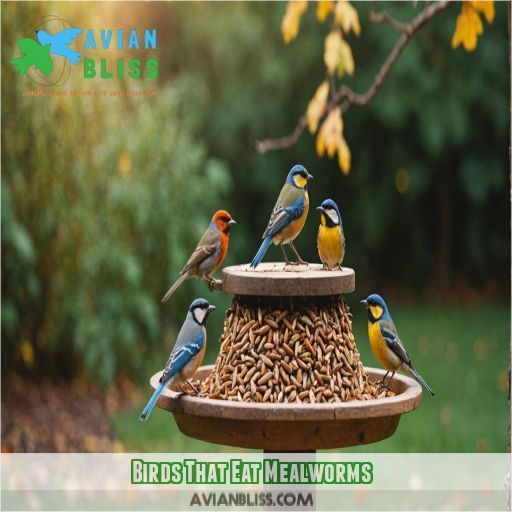
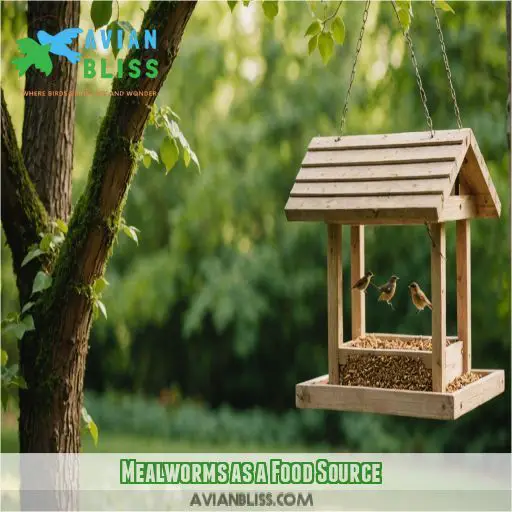
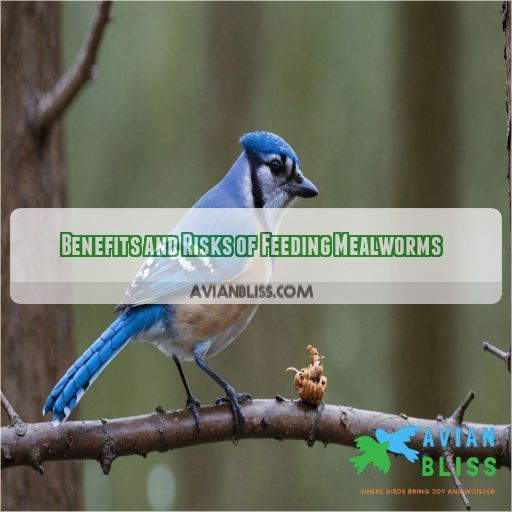
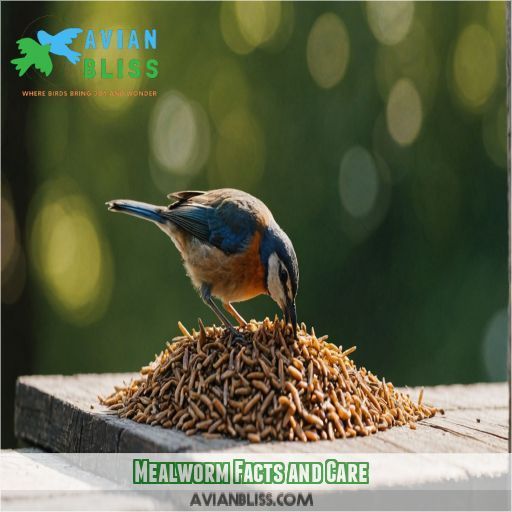
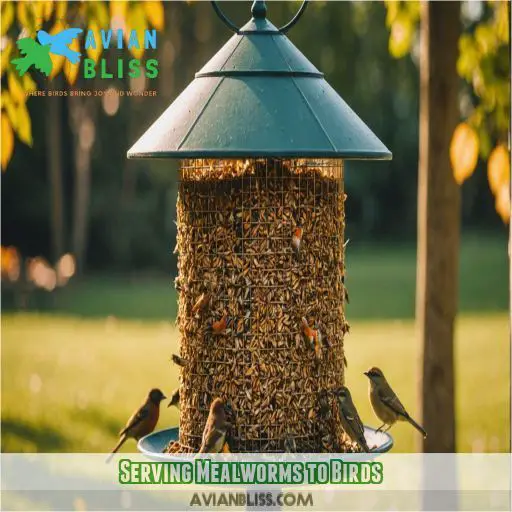
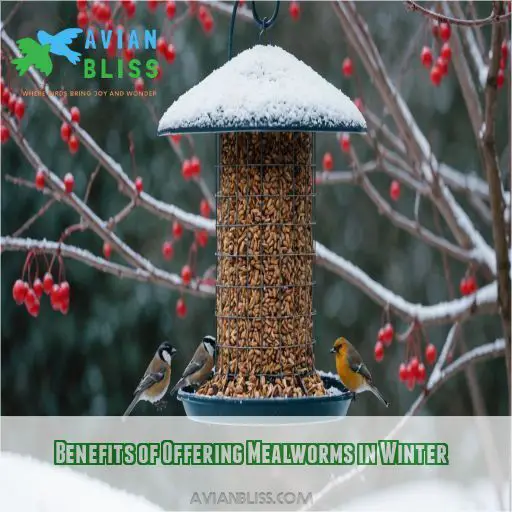


0 Comments